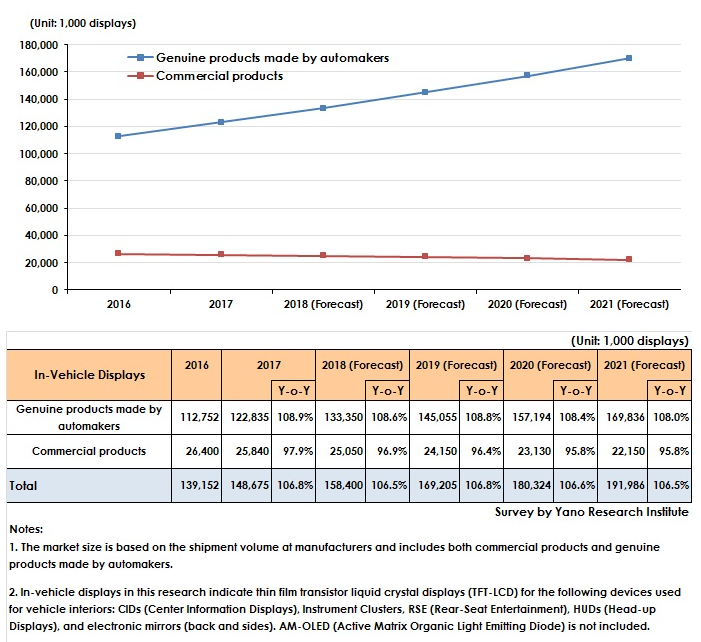No.2039
Global In-Vehicle Display Market: Key Research Findings 2018
Global In-Vehicle Display Market: Key Research Findings 2018
Yano Research Institute (the President, Takashi Mizukoshi) has conducted a survey on the in-vehicle display market and has found out the shipment volume of commercial products as well as genuine products made by automakers, the market trends by part and by inch, and the price trend.

Market Overview
The global in-vehicle display market size in 2017, which includes the size of commercial products as well as genuine products made by automakers, rose to 148,675 thousand, 106.8% of that in the previous year, based on the shipment volume at manufacturers.
In the in-vehicle display market, TFT-LCDs (thin film transistor liquid crystal displays) show overwhelming popularity with their longtime trust. TFT-LCDs are introduced as standard in-vehicle CIDs (Center Information Displays) and are increasingly adopted as Instrument Clusters which have been increasingly replaced from TN/STN to TFT. In addition, they are also newly introduced as main displays of HUDs (Head-up displays) and electric rearview and side mirrors. Therefore, along with expansion of the in-vehicle display market, the TFT/LCD market is also likely to continue growing for the time being.
Noteworthy Topics
In-vehicle AM-OLED (Active Matrix Organic Light Emitting Diode) has been expected as a next-generation display, and is likely for Audi to adopt AM-OLED screens for CIDs and for electric side mirrors. Mercedes-Benz is also scheduled to introduce AM-OLED screens.
Although in-vehicle AM-OLED has been highly reputed for its high contrast, it also has some challenges, i.e., the matter of brightness, afterimage, and duration of life, which have not yet completely satisfied the conditions of being the part of an automobile. Therefore, AM-OLED has been initially introduced only in a control screen (Remote) for RSE (rear seat entertainment). However, it is likely to be test-shipped as CIDs and side mirrors for Audi’s new automobile models.
Although there are some challenges to be solved as an in-vehicle display, the key to increase the introduction of AM-OLED lies in how their characteristics of high-contrast and flexibility will be assessed in the improved AM-OLEDs prior to full introduction.
Research Outline
2.Research Object: In-vehicle display manufacturers
3.Research Methogology: Face-to-face interviews by the specialized researchers and literature search
What are In-Vehicle Displays?
In-vehicle displays in this research indicate thin film transistor liquid crystal displays (TFT-LCD) for the following devices used for vehicle interiors: CIDs (Center Information Displays), Instrument Clusters, RSE (Rear-Seat Entertainment), HUDs (Head-up Displays), and electronic mirrors (back and sides). AM-OLED (Active Matrix Organic Light Emitting Diode) is not included.
Published Report
Contact Us
The copyright and all other rights pertaining to this report belong to Yano Research Institute.
Please contact our PR team when quoting the report contents for the purpose other than media coverage.
Depending on the purpose of using our report, we may ask you to present your sentences for confirmation beforehand.